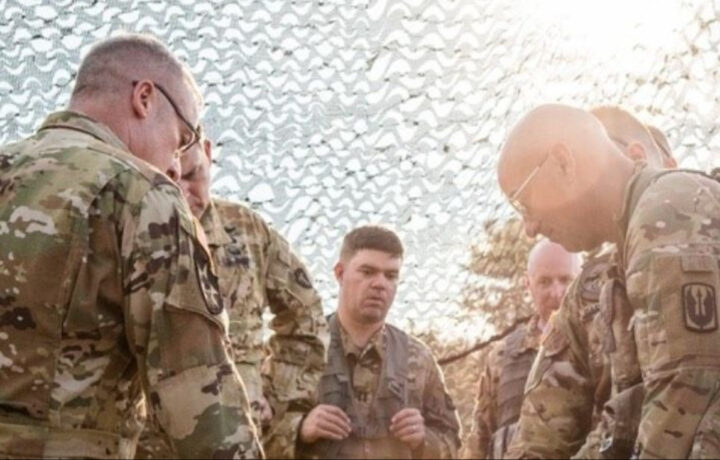The war in Ukraine has proven that the old ways aren’t always the best, even if much of the fighting remains low-tech and old-fashioned. Yet, low-cost commercial drones have been used to help Kyiv’s artillery conduct precision strikes on enemy positions, while both sides have been employing loitering munitions – also known as kamikaze drones – to target the other side’s tanks and vehicles.
This has put the future of armor in question, as drones have become a game-changer in Ukraine.
Future Military Tech
The United States Department of Defense (DoD) has been closely watching the war to determine the role that technology can play in future conflicts. In addition to autonomous vehicles and platforms that can seek out an adversary, the Pentagon is seeking to advance another key facet of the modern battlefield, namely the decision-making process.
Split-second decisions can literally mean the difference between life and death, and victory and defeat. The right decisions at the right time can also ensure it doesn’t come to a life-and-death moment.
This week, the DoD announced that it had awarded the University of Houston a $63.5 million contract, the largest grant ever awarded to the higher learning institution. The school will aid the U.S. Army in the development of the technology to make effective and timely decisions with a strong analytical foundation to gain dominance over adversaries today and into the future.
“We are immensely honored to have been awarded this important contract from the Department of Defense,” said Renu Khator, University of Houston president. “We understand the significance of this project in enhancing the Army’s decision-making capabilities, and we are proud to contribute to our nation’s security and strategic competitiveness. We look forward to the remarkable contributions that will emerge from this collaboration, strengthening the University of Houston’s commitment to driving innovation that matters.”
Analytical Modeling and Simulation
Researchers at the Carnegie-designated Tier One research university will explore and innovate in the realm of analytical modeling and simulation to enhance the U.S. Army’s decision-making during long-term strategic competition, as well as in struggles among nations that occur when pursuing incompatible interests without necessarily being engaged in armed conflict.
“We are not looking at what happens once bullets start flying,” said Craig Glennie, professor of civil and environmental engineering and director of engineering defense research initiatives at the UH Cullen College of Engineering
Glennie, who is leading the project team that also includes the University of Massachusetts Amherst and New Mexico State University, among others, explained that this effort will examine what happens during the competition and crisis phases, the buildup and the posturing and the projection of forces before it actually gets to the point of armed conflict
“The Army needs tools to understand how they can effectively position themselves and project their force towards the adversary in such a manner that they can avoid armed conflict, or if that is not possible, be prepared for the onset of armed conflict,” Glennie added.
Changing the Decision-Making Process
The Pentagon has noted that contemporary U.S. Army decision-making now bears little resemblance to its historical counterparts. The service is also undergoing the most significant reorganization and technical innovation since the end of the Cold War — ensuring that adversaries cannot outrange or outpace America on traditional battlefields, or gain an advantage in the new frontiers of space and cyberspace.
Glennie’s team will work with the U.S. Army Combat Capabilities Development Command (DEVCOM) Analysis Center (known as DAC) – the “brains” to the “brawn” of the Army’s military might – to develop realistic modeling, analysis, and simulation tools for new technologies that the service is responsible for integrating into the future battlefield.
“For example, we will look at the electromagnetic spectrum, at owning the airspace, and projecting that we have the radio frequency technology that is capable of jamming a neighbor’s signals,” explained Glennie.
DAC’s analytical foundation will inform U.S. Army modernization and readiness decisions by conducting thorough analyses. It has already identified several high-priority research areas, including quantum technology, artificial intelligence (AI), and machine learning. In total, the program will focus on six broad categories with numerous objectives to provide valuable insights to commanders at all levels, to inform on the most critical decisions.
Joint Concept Competing
The new University of Houston-led effort comes as the U.S. Joint Chiefs of Staff recently issued a major paper on U.S. strategy entitled “Joint Concept for Competing” in which officials posited that “competition does not always mean hostility and does not preclude cooperation. Nor does the United States view strategic competition as an inevitable march to armed conflict. Done properly, there is much to gain from strategic competition, something U.S. adversaries have already realized.”
The selection of the University of Houston for this critical project has also been seen to reaffirm the school’s role as an innovation hub, and that its researchers are making impactful strides in real-world applications.
“The stakes here are high, but we accept the challenge of advancing the frontiers of analytical modeling and simulation to assist the Army in an ever-evolving global landscape,” added Ramanan Krishnamoorti, University of Houston vice president of energy and innovation.




